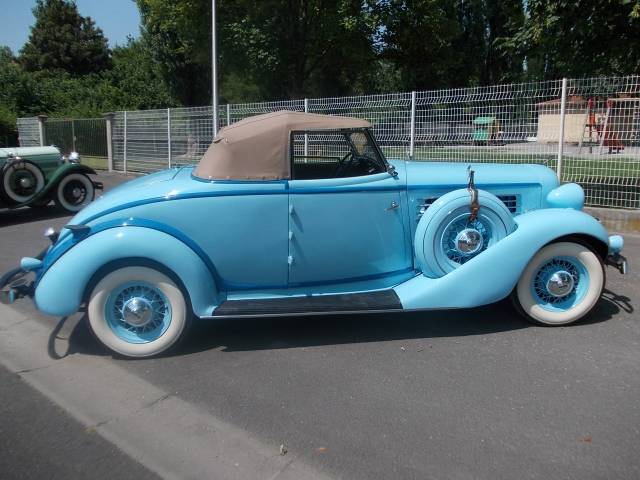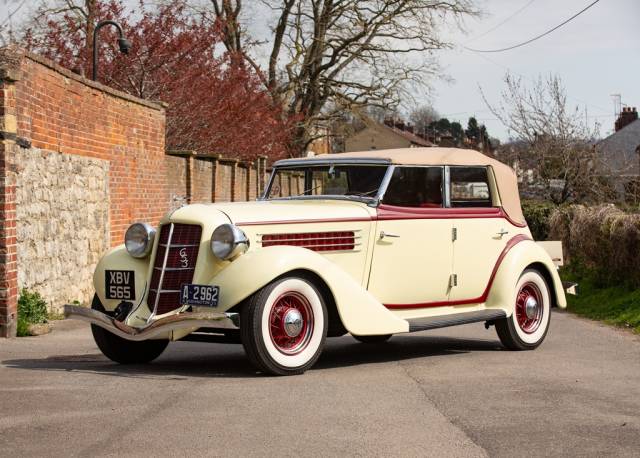Auburn 653 classic car for sale
The Auburn 653 stands as a testament to 1920s American engineering and luxury, blending distinctive design with robust technical execution. Enthusiasts appreciate its place as a representative of pre-war motoring sophistication and mechanical ingenuity. Discover what makes the Auburn 653 unique among classic vehicles of its era.
Search results

1935 | Auburn 653
AUBURN Cabriolet 653, entièrement restaurée
Auburn 653 listing references from Classic Trader
Below you will find listings related to your search that are no longer available on Classic Trader. Use this information to gain insight into availability, value trends, and current pricing for a "Auburn 653" to make a more informed purchasing decision.

1935 | Auburn 653
Auburn Phaeton 653 Cabriolet
History of the Auburn 653
The Auburn 653 emerged during a time when American manufacturers pursued technical ambition and striking aesthetics to distinguish themselves. Auburn, known for its advanced engineering and competitive pricing, positioned the 653 as an accessible yet refined six-cylinder automobile within its line-up around the late 1920s. This model reflected Auburn’s strategy to elevate its status by offering cars with advanced features such as hydraulic brakes, high-compression engines, and well-crafted interiors. The 653 contributed to Auburn's reputation for delivering vehicles that combined dependable mechanicals with stand-out styling, serving as a cornerstone before the company’s shift toward even grander eight- and twelve-cylinder models in the early 1930s.
Model lineage and development
The Auburn 653 succeeded earlier Auburn six-cylinder models, representing an evolution in reliability, performance, and comfort. The series paved the way for Auburn’s signature eight-cylinder models, providing the technological and design foundation that later boasted supercharged engines and more elaborate coachwork. The 653 holds its place in Auburn’s legacy as a bridge between trustworthy touring cars of the 1920s and the more flamboyant vehicles that defined the marque’s golden age.
Highlights and distinctive features
Key features of the Auburn 653 include its inline six-cylinder powerplant, robust chassis, and a body often finished in two-tone paint schemes characteristic of the period. Auburn models from this era were known for introducing hydraulic brakes and technical innovations that set them apart within their segment. The 653 is distinguished by its blend of affordability and luxury—a rare balance in its market of origin.
Technical data
Special editions and collectible models
No information about special limited editions of the Auburn 653 has been recorded for the market. However, variations in body styles and individual coachwork might make some examples more sought-after depending on configuration and historical provenance.
Weak spots and common issues
No specific weak spots have been reported for the Auburn 653 in the current database. As with most American vehicles of the late 1920s, general points of attention would include the condition of the braking system, wiring, and body integrity, particularly when restoring or maintaining rarely driven examples.
Engine, performance, transmission and handling
The Auburn 653 was equipped with a six-cylinder engine providing sufficient power for its class, with the focus more on smoothness and reliability than outright acceleration. The manual transmission was robust and straightforward, designed for durability. The ride is characterized by long spring travel and a solid axle, delivering a comfortable touring experience even across challenging surfaces typical of the era. Standard hydraulic brakes offered progressive stopping power, rare among competitors of the same period. In the Auburn 653 range, the standard sedan and phaeton body styles were most common, valued for their spacious interiors and practicality. The sedan especially reflects the typical family touring saloon, while touring variants appeal to open-air motoring enthusiasts.
Interior, comfort, exterior and design
Typical for Auburn, the 653 demonstrated attention to body proportions, with a long bonnet, flowing wings, and chromed details. Interiors featured quality materials such as leather or mohair upholstery and art-deco inspired dashboard gauges. Two-tone paintwork and wire-spoked wheels often complemented the car’s presence. Accessories like dual side-mount spares and chrome bumpers were not uncommon, further underlining its pre-war appeal. Individual coachbuilders occasionally enhanced the Auburn 653 with unique design elements, tailored fittings, or custom paint finishes.
Other notable features
Beyond its technical and aesthetic details, some Auburn 653s may feature period accessories including luggage racks, wind deflectors, or custom instrumentation, depending on their original or restored configuration.
Summary
The Auburn 653 encapsulates the ambition and style of late-1920s American motoring, standing as the most represented Auburn model in the current market. Its blend of six-cylinder reliability, advanced hydraulic brakes, and appealing period design continues to attract enthusiasts who value authentic mechanical character and distinctive pre-war aesthetics.
